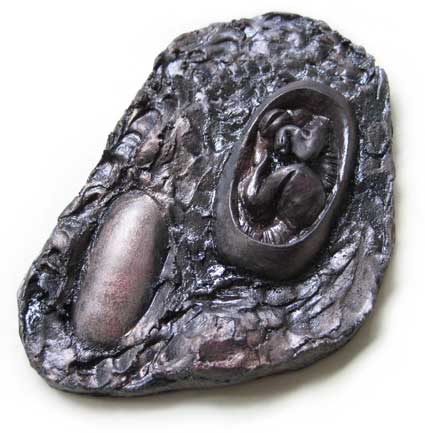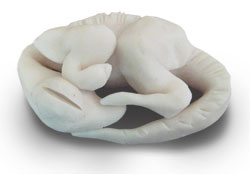

All you need is a lid from a deodorant or other personal care product and if you want, a tiny bit of oven bake modeling clay. Lids that are circular in plan view and have a nice rounded top are perfect for the job. If you want to make the dinosaur embryo, then you'll need a bit of modeling clay, and ideally the sort that hardens in the oven, but you don't have to make the dinosaur, because most real fossilised dinosaur eggs have been found without anything inside. If you have more than one lid then you can make more than one egg or you can could break the lid into bits and stick them next to an unbroken egg to make it look like there was another egg in the same nest that had already been hatched.
. . . Fossilized dinosaur eggs are very rare, especially ones with embryos in them, because exceptional conditions were needed to make a fossil. The most famous dinosaur egg fossils were found in South Africa in 1978 while workmen were digging to build a new road. However it was nearly 30 years before paleontologists had the right technology and were brave enough to chip away the outer coating of the fossil eggs to reveal the inner dinosaur embryo. They had to be very careful because the eggs were 190 million years old and extremely valuable.
. . . Now you might think that because dinosaurs were enormous, that their eggs would be gigantic too, but this is not the case, even big dinosaurs had small eggs. The eggs you are going to make in this project are about the right size for a large plant eating sauropod. Just like in the real fossil, your dinosaur embryo will look almost exactly like a bird embryo. With a large head and small body and four legs of about the same size, it is thought that when hatched the baby dinosaurs would not have been able to look after themselves. So, just like birds, the baby dinosaurs were probably looked after and fed by their parents until they were big enough to leave the nest and fend for themselves. dinosaur embryo modelScientists were amazed to discover the shape of the embryos and have worked out that as they grew to maturity, their heads must have grown much less than their bodies, so that by the time they were fully grown, they had tiny heads and huge bodies.
. . .Despite what you might think, dinosaur fossils are very rare, and it is tiny glimpses like this into what an embryonic dinosaurs looked like that helps scientists piece together theories of how dinosaurs evolved.
For more information related to dinosaurs, visit rareresource.com.

0 comments:
Post a Comment